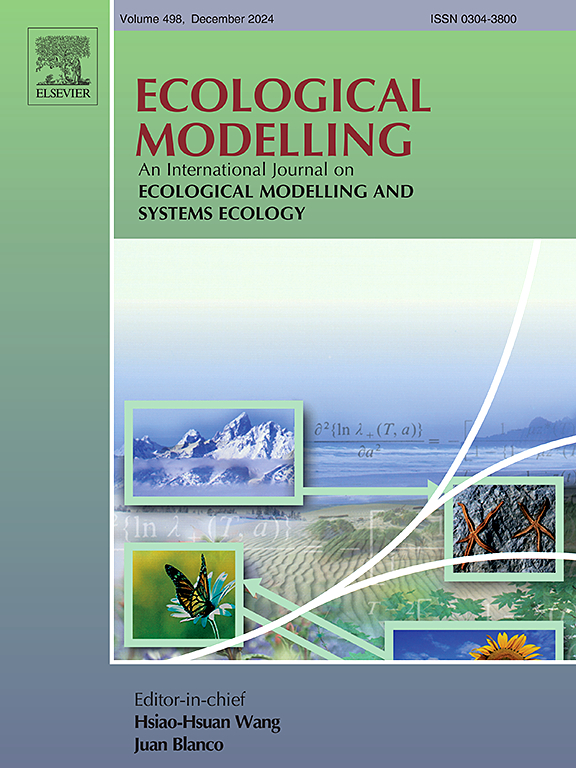How does shifting wood products between uses affect their carbon dynamics and climatic impacts? Leveraging MoSiR, a new carbon accounting tool
IF 3.2
3区 环境科学与生态学
Q2 ECOLOGY
引用次数: 0
Abstract
Achieving climate change mitigation targets set in international pledges requires identifying optimal strategies for forest management and wood utilization.
Our study quantified the carbon storage and emission dynamics of the forestry sector using Quebec (Canada) as a case study, focusing on wood products in service and in solid waste disposal sites, over an 80-year period using material flow analysis and a simple decay approach. We assessed carbon stock dynamics and climate change mitigation potential for a business-as-usual (BaU) scenario and seven alternatives. Mitigation potentials were determined by comparing the cumulative climatic effect, expressed as the radiative forcing of greenhouse gas emissions, of each alternative scenario relative to the BaU. These scenarios included variations in wood processing, recycling rates, durability enhancements, and solid waste disposal sites management to evaluate their effects on carbon storage and emissions. Modeling was performed with MoSiR, a new tool developed by Québec’s Office of the Chief Forester, simulating different wood product flows and emissions.
Although long-lived wood products provide substantial carbon storage benefits, they currently constitute only a small portion of the wood processing mix. Focusing solely on these products may therefore overlook the broader climate impact of the forestry sector. Our study highlights that the mitigation potential of wood products largely depends on a product mix that prioritizes durability and circularity. Such a mix extends carbon storage duration and reduces the demand for virgin materials, thereby lowering the climate impact of harvesting by reducing the total area disturbed. Although wood product decay is not traditionally a forest management concept, the fact that harvesting is conducted to produce wood products means that the associated GHG emission dynamics, especially those from solid waste disposal sites, should be part of foresters’ considerations. Our findings emphasize the importance of precise modeling of wood product decay and support policies aimed at reducing emissions from solid waste disposal sites, enhancing substitution effects, and prioritizing long-lived wood products.
木材产品在不同用途之间的转换如何影响其碳动态和气候影响?利用MoSiR,一个新的碳核算工具
实现国际认捐中确定的减缓气候变化目标需要确定森林管理和木材利用的最佳战略。我们的研究以加拿大魁北克省为例,对80多年来林业部门的碳储存和排放动态进行了量化,重点研究了服务和固体废物处理场的木材产品,使用了物质流分析和简单的衰变方法。我们评估了“一切照旧”(BaU)情景和七种备选方案的碳储量动态和减缓气候变化潜力。通过比较每个备选情景相对于BaU的累积气候效应(表示为温室气体排放的辐射强迫)来确定缓解潜力。这些方案包括木材加工、回收率、耐久性增强和固体废物处置场地管理方面的变化,以评估其对碳储存和排放的影响。建模使用了MoSiR,这是一种由qusamube的首席森林管理员办公室开发的新工具,模拟了不同的木材产品流动和排放。虽然长寿命的木材产品提供了大量的碳储存效益,但它们目前只占木材加工组合的一小部分。因此,仅仅关注这些产品可能会忽视林业部门更广泛的气候影响。我们的研究强调,木材产品的减排潜力在很大程度上取决于优先考虑耐用性和循环性的产品组合。这样的混合延长了碳储存时间,减少了对原始材料的需求,从而通过减少受干扰的总面积来降低采伐对气候的影响。虽然木材产品腐烂在传统上不是森林管理的一个概念,但采伐是为了生产木材产品,这一事实意味着相关的温室气体排放动态,特别是来自固体废物处理场的温室气体排放动态,应该是林业人员考虑的一部分。我们的研究结果强调了木制品腐烂精确建模的重要性,以及支持旨在减少固体废物处理场排放、增强替代效应和优先考虑长寿命木制品的政策。
本文章由计算机程序翻译,如有差异,请以英文原文为准。
求助全文
约1分钟内获得全文
求助全文
来源期刊

Ecological Modelling
环境科学-生态学
CiteScore
5.60
自引率
6.50%
发文量
259
审稿时长
69 days
期刊介绍:
The journal is concerned with the use of mathematical models and systems analysis for the description of ecological processes and for the sustainable management of resources. Human activity and well-being are dependent on and integrated with the functioning of ecosystems and the services they provide. We aim to understand these basic ecosystem functions using mathematical and conceptual modelling, systems analysis, thermodynamics, computer simulations, and ecological theory. This leads to a preference for process-based models embedded in theory with explicit causative agents as opposed to strictly statistical or correlative descriptions. These modelling methods can be applied to a wide spectrum of issues ranging from basic ecology to human ecology to socio-ecological systems. The journal welcomes research articles, short communications, review articles, letters to the editor, book reviews, and other communications. The journal also supports the activities of the [International Society of Ecological Modelling (ISEM)](http://www.isemna.org/).
 求助内容:
求助内容: 应助结果提醒方式:
应助结果提醒方式:


